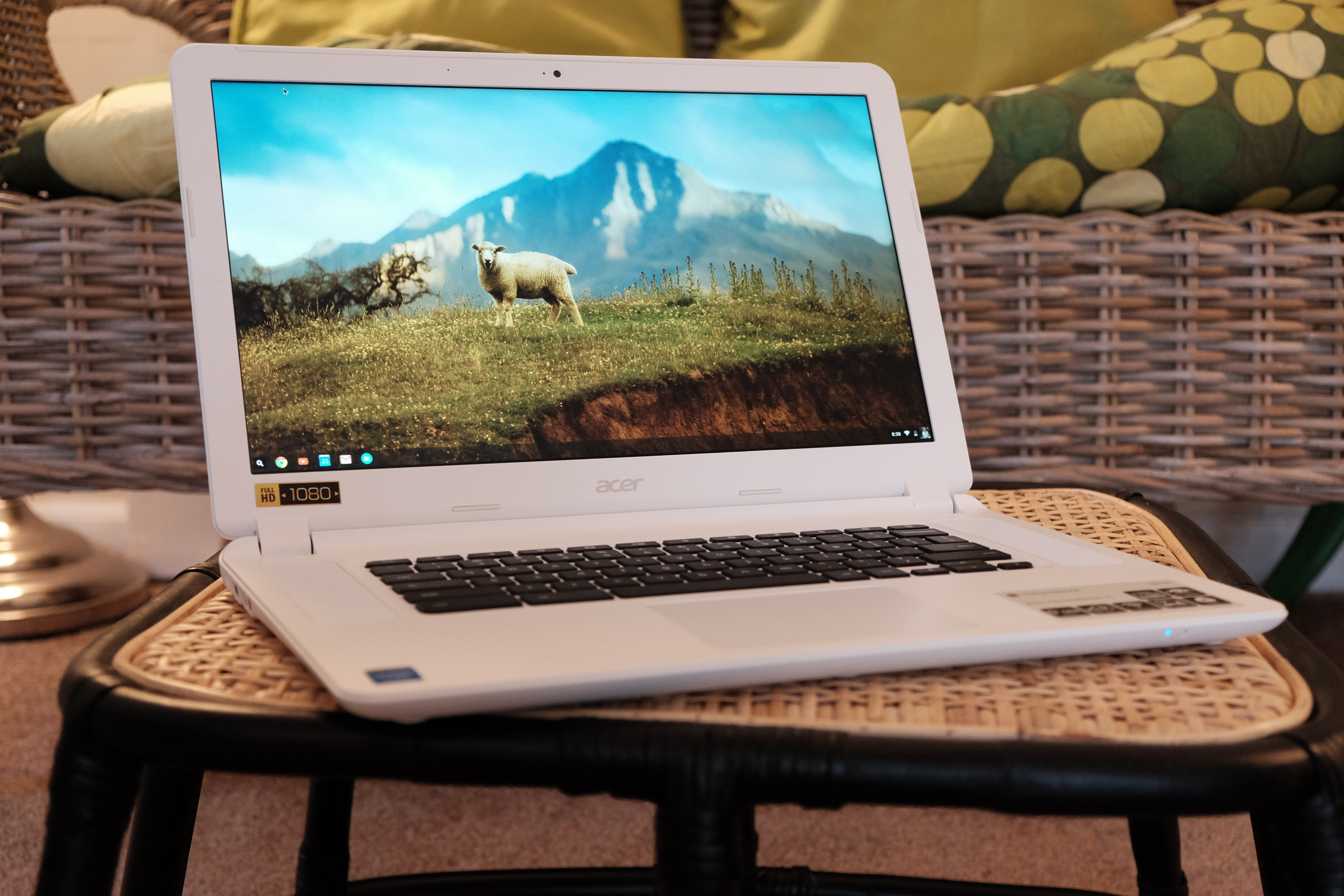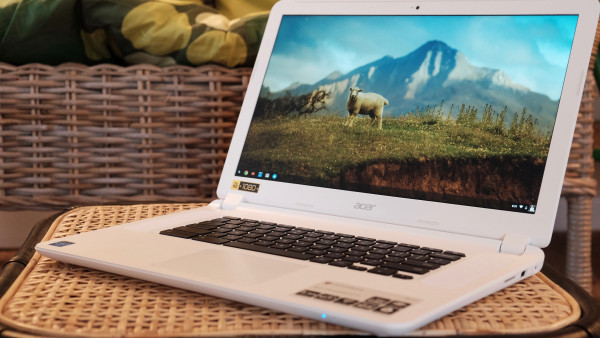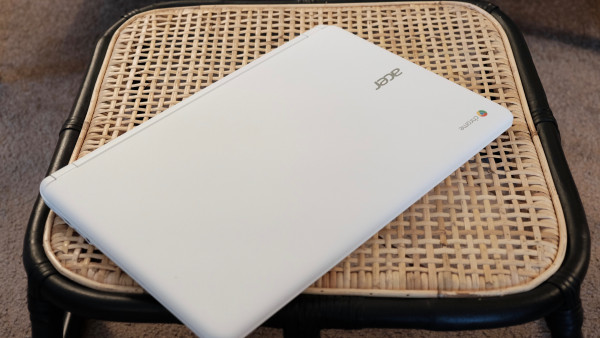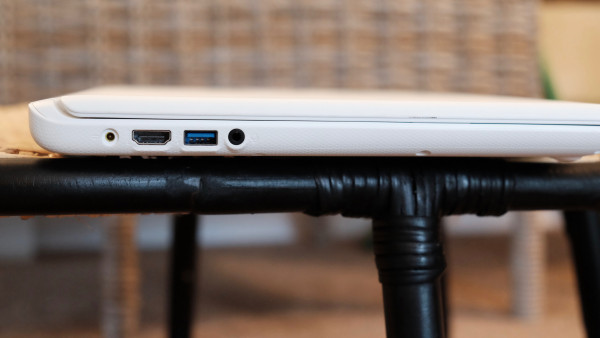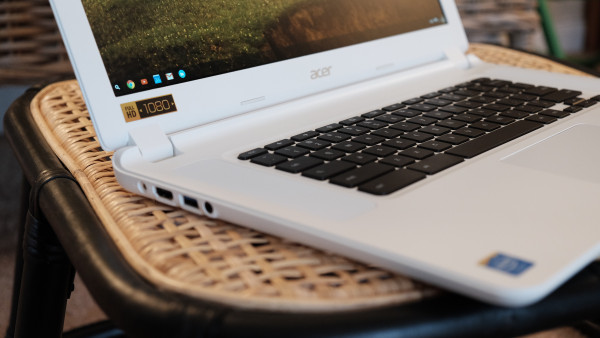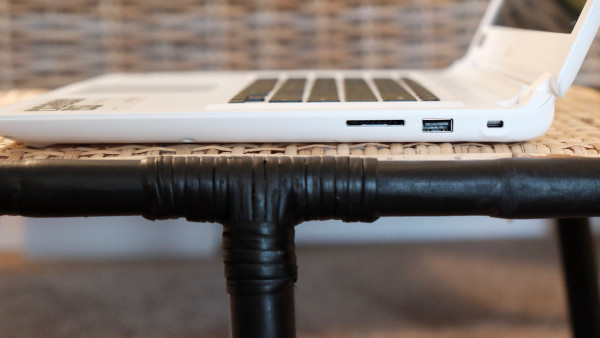I am not a fan of overly-large laptops, but if I were to buy one, Acer’s 15.6-inch monster would be among my top choices. The Chromebook packs in lots of value, which first and foremost is 1080p resolution to match the large screen, a benefit that is atypical for the price and size class. Screen brightness is no match for the Toshiba Chromebook 2, but the matte finish compensates for dimness by dramatically reducing glare. Meanwhile, the IPS display gives great viewing angles.
The point: Acer doesn’t just offer bigger, but better, among the overall Chromebook category, where dim TN screens are standard fare. That also can be said of competing Windows laptops, where with same size screen in the price range, or even more costly, resolution typically tops out at 1366 x 768. Chromebook 15 is 1920 x 1080. By more than size, the display is a big benefit.
In my testing, watching movies, TV shows, or YouTube is a treat, with all that real estate. With so much landscape available to accommodate the display, Acer wastes not. Speakers flank the keyboard on either side, providing booming sound with surprisingly crisp definition. The screen and speakers combination is unmatched by any other Chromebook, most Windows PCs, and no Mac portables. This is a huge benefit for someone streaming, say, in a college dorm room rather than watching TV.
But big is, well, big. The screen and speakers demand large enclosure and heft with it. Size matters. Length, width, height: 38.4 x 24.4 x 2.54 cm (15.1 x 9.6 x 1 inches). Weight: 2.2 kilograms (4.85 pounds). While absolutely luggable, Chromebook 15 might be better for the person who needs an occasional computer carry-about.
That said, Chromebook 15 isn’t an uncomfortable carry-along. The surface grips firmly and provides plenty of friction in the hand. But if appearance matters, you will look something of a dork lugging this thing around. Use a backpack.
Regarding appearance, Acer’s Chrome OS hunk isn’t handsome. It’s not ugly, per se, just not the prettiest design. The plastic is obvious and dull, but more pronounced in the signature white model than the black one. But, hey, this is a budget notebook which big benefits balance with the HD screen. The visual that matters more is what you see on the large display. Chromebook 15 is superb example of a manufacturer putting function before form.
The keyboard is typical Acer, which, while good, falls short of the Chromebook category. Keys are a somewhat stiff and noisy, although responsive enough. The trackpad is smooth but like the keys is a bit click, click, clicky.
Performance is snappy, which is typical of Acer Chromebooks. This one packs a 5th-generation Intel Celeron processor that gives more bang than I would expect. I tested a model with 4GB of RAM and found it to be spiffy responsive even with 15 or more browser tabs open. Another measure is video streaming, which largely is smooth and stutter-free.
Battery life is excellent and certainly good enough for a full school or work day. I typically see 6 to 8 hours, depending on use. Seven to 7.5 hours is my average. If you want 10 or 12 hours, choose a laptop with smaller screen to light up. You can gain time by dimming the brightness, but full-lum only satisfies my eyes.
There are a handful of available configurations, one of which I wouldn’t recommend. Base specs: 1.5GHz Intel Celeron 3205U dual-core processor; 15.6-inch display; Intel HD graphics; 720p webcam; SD card reader, HDMI port; USB 2 and 3 ports (one each); WiFi N; 3220 mAh battery; and Chrome OS.
At $249.99, you get 2GB RAM, 16GB SSD, and display with 1366 x 768 resolution. I recommend against buying this model. Chromebook 15’s major benefits revolve around the 1080p IPS screen, which the entry-level model lacks. For $299.99, Acer gives the better screen and 4GB RAM. The top-end model doubles the storage for another $50. Also available, for $329.99, 32GB storage but only 2GB RAM.
For big spenders demanding more performance, Acer also offers a $449 Chromebook 15, with Core i3 processor, 4GB RAM, 32GB storage and Intel HD 550 graphics. For $50 more, you can go Core i5.
Chromie Lifestyle
Acer Chromebook 15 rounds off the category by filling the vacant big niche. Eleven and 12-inch displays are more typical, although there are several 13.3-inchers to choose from. The larger question should be: Is any Chromebook right for you?
Laptops in this class run Chrome OS, which essentially is Google’s browser as user interface to hybrid-Linux core. While there is a desktop and file manager, nearly all activity takes place in Chrome tabs. Webapps replace applications that run locally.
Chromebook isn’t a computer-purchasing decision—it’s a lifestyle choice. The device fits into a contextual lexicon of others that are cloud connected. Your lifestyle hub shifts from the PC as center to apps and services reaching many devices. The post-PC era is a myth. There is no such thing. We live in the contextual cloud computing era, where, as a web-centric device, Chromebook fits nicely—even while representing a dying PC paradigm.
I see 10 major benefits to Chromebook ownership:
- Easy setup
- Guest-user account
- Fast crash recovery
- Instant-on capability
- Security architecture
- High-value for low-cost
- Simplicity and usability
- Hands-free IT management
- Frequent updates delivered easily
- Seamless sync with devices running Chrome
Quickly explained:
- Setup is as easy as logging into Google account. That’s it!
- Guest user account lets others share your laptop without accessing your stuff.
- My Chromebook 15 tester never crashed, but recovery would take just a few seconds had it.
- To start up, you flip the lid, and the log-in prompt appears with near-immediacy.
- Chrome OS is remarkably hardy against hacking or intrusion.
- As Acer demonstrates, you get a lot of laptop for the price, and cloud apps are free or cost considerably less than would PC software.
- Features like log in to setup make Chrome OS easier to manage than OS X or Windows PCs.
- Google updates Chrome OS about every 6-8 weeks. You get new features without the hassle of breaking apps.
- Synchronization is the killer app for the connected era, and Google gives better than any competitor. Example: Browser tabs and settings sync across devices.
Chromebook isn’t for everyone, particularly those people who need to use legacy applications. For the rest, if whatever you need works in the browser, you’re set for Chrome OS. Perhaps Acer’s hunk, or something smaller.
Editor’s Note: A version of this story appears on BetaNews.
